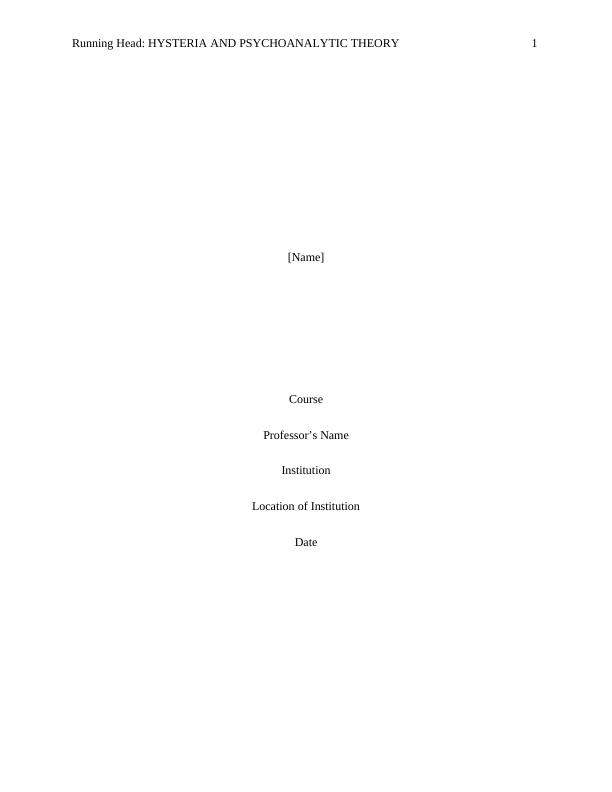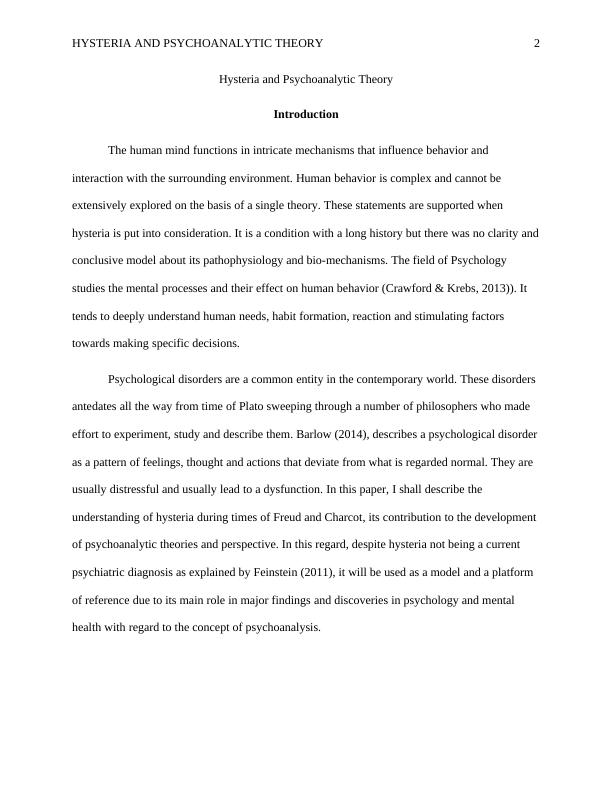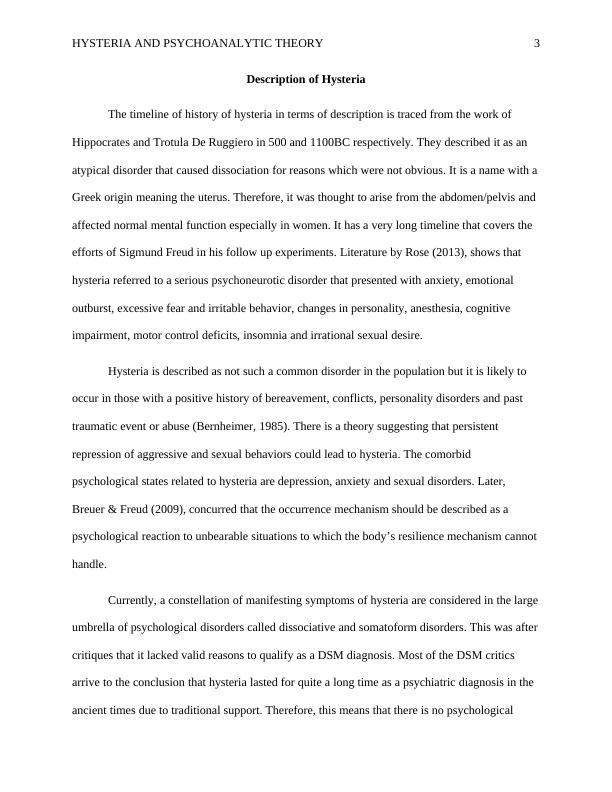Date Hysteria and Psychoanalytic Theory
15 Pages4644 Words71 Views
Added on 2021-04-16
Date Hysteria and Psychoanalytic Theory
Added on 2021-04-16
ShareRelated Documents
Running Head: HYSTERIA AND PSYCHOANALYTIC THEORY 1[Name]CourseProfessor’s NameInstitutionLocation of InstitutionDate

HYSTERIA AND PSYCHOANALYTIC THEORY 2Hysteria and Psychoanalytic TheoryIntroductionThe human mind functions in intricate mechanisms that influence behavior and interaction with the surrounding environment. Human behavior is complex and cannot be extensively explored on the basis of a single theory. These statements are supported when hysteria is put into consideration. It is a condition with a long history but there was no clarity andconclusive model about its pathophysiology and bio-mechanisms. The field of Psychology studies the mental processes and their effect on human behavior (Crawford & Krebs, 2013)). It tends to deeply understand human needs, habit formation, reaction and stimulating factors towards making specific decisions. Psychological disorders are a common entity in the contemporary world. These disorders antedates all the way from time of Plato sweeping through a number of philosophers who made effort to experiment, study and describe them. Barlow (2014), describes a psychological disorderas a pattern of feelings, thought and actions that deviate from what is regarded normal. They are usually distressful and usually lead to a dysfunction. In this paper, I shall describe the understanding of hysteria during times of Freud and Charcot, its contribution to the development of psychoanalytic theories and perspective. In this regard, despite hysteria not being a current psychiatric diagnosis as explained by Feinstein (2011), it will be used as a model and a platform of reference due to its main role in major findings and discoveries in psychology and mental health with regard to the concept of psychoanalysis.

HYSTERIA AND PSYCHOANALYTIC THEORY 3Description of HysteriaThe timeline of history of hysteria in terms of description is traced from the work of Hippocrates and Trotula De Ruggiero in 500 and 1100BC respectively. They described it as an atypical disorder that caused dissociation for reasons which were not obvious. It is a name with aGreek origin meaning the uterus. Therefore, it was thought to arise from the abdomen/pelvis and affected normal mental function especially in women. It has a very long timeline that covers the efforts of Sigmund Freud in his follow up experiments. Literature by Rose (2013), shows that hysteria referred to a serious psychoneurotic disorder that presented with anxiety, emotional outburst, excessive fear and irritable behavior, changes in personality, anesthesia, cognitive impairment, motor control deficits, insomnia and irrational sexual desire. Hysteria is described as not such a common disorder in the population but it is likely to occur in those with a positive history of bereavement, conflicts, personality disorders and past traumatic event or abuse (Bernheimer, 1985). There is a theory suggesting that persistent repression of aggressive and sexual behaviors could lead to hysteria. The comorbid psychological states related to hysteria are depression, anxiety and sexual disorders. Later, Breuer & Freud (2009), concurred that the occurrence mechanism should be described as a psychological reaction to unbearable situations to which the body’s resilience mechanism cannot handle. Currently, a constellation of manifesting symptoms of hysteria are considered in the largeumbrella of psychological disorders called dissociative and somatoform disorders. This was aftercritiques that it lacked valid reasons to qualify as a DSM diagnosis. Most of the DSM critics arrive to the conclusion that hysteria lasted for quite a long time as a psychiatric diagnosis in the ancient times due to traditional support. Therefore, this means that there is no psychological

HYSTERIA AND PSYCHOANALYTIC THEORY 4diagnosis of hysteria and its associations such as female hysteria, conversion hysteria, mass, anxiety hysteria and male hysteria in the current mental diagnostic practice. The DSM- IV states that the symptoms which were formerly relevant for the diagnostic criteria of hysteria are conclusively covered under dissociative and somatoform disorders.Dissociative disorders refer to a group of psychopathologies characterized by a disruptionin the unitary state of self or disturbances in the experience of self, resulting in a lack of connection in a person‘s thoughts, memories and feelings, actions or sense of identity. The term dissociation infers a mechanism that allows the mind to separate or compartmentalize certain memories or thoughts from normal consciousness. These split-off mental contents are not erased.They may resurface spontaneously or be triggered by objects or events in the person's environment. The DSM-4 classification of dissociative disorders include: - dissociative fugue, dissociative amnesia, derealisation, dissociative identity disorder and depersonalization disorder. On the other hand, somatoform disorders comprises a group of mental disorders characterized bya firm belief of suffering, abnormal body sensations, excessive worry and dislike of body parts. This disease cluster consists of body dysmorphic disorder, conversion disorder, somatization disorder, hypochondriasis, factitious disorder and somatoform pain disorder. Symptoms of these disorders were given the diagnosis of hysteria by early theorists in order to apply a standardized mode of therapy to the affected patients.The psychoanalytic theory was developed by Sigmund Freud (1856-1939). This theory has a special emphasis on importance of childhood activities and experiences in shaping personality. He successfully described the structural/tripartite model which consists of the id, egoand superego. The mind changes its state depending on the pleasure principle. This is the constant drive to reduce tension and stress through expression of instinctual urges. The id is the

End of preview
Want to access all the pages? Upload your documents or become a member.
Related Documents
Psychopathology Mental Incapability docx.lg...
|4
|779
|12
Introduction to Psychology: Psychoanalytic Approach and Behavioural Approachlg...
|5
|1384
|267
Cognitive Behavioral Approaches in Treating Psychological Disorderslg...
|3
|536
|155
Media Report Critiquelg...
|10
|2645
|336
Psychodynamic Theory: Application and Justification in a Case Studylg...
|9
|2310
|29
Mental Health Case Study: Diagnosis, Stress Vulnerability Model, and Recovery Processlg...
|9
|2561
|59
